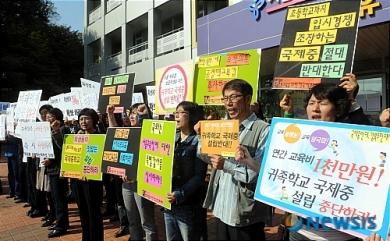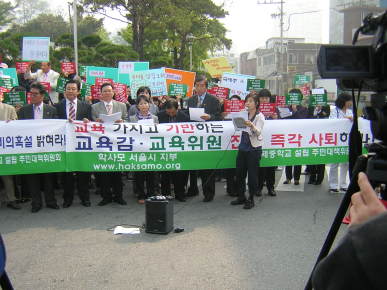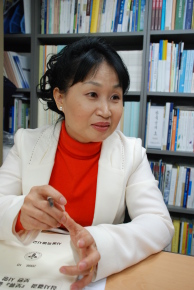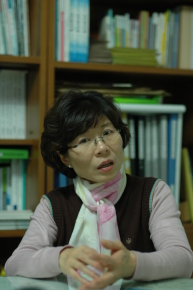International middle-schools to be legalized in Seoul
CHRISTMAS IT was. Like last year, the whole family gathered to share red and green festivities. Amidst this joyful gathering, the usual giggling of the youngest cousin, Sohee, who is a fifth grader at elementary school, was missing. The aunt told the family that she was at the Christmas special lecture session in the private academy that prepares elementary students for the entrance examination to international middle schools. These days, the reality is that the chance of seeing young cousins in elementary school has become narrower, as they spend more time in private academies with the advent of international middle schools. It was announced by the government that two public international middle schools will be established in Seoul. The question is: will these schools really nurture global young leaders, or rather foster the growth of private academies?
What are international middle schools?
The original intention behind international middle schools is to cultivate a global mindset and leadership skills by educating Korean students in all-English classes. In this rapidly globalizing world, people are no longer bound to one nation; movement of human resources across the international border is encouraged. To cross these territorial limits freely, linguistic skills are essential. Thus, from an early age, the importance of the global language, English, is stressed. Over 30 foreign language high schools have been established, whereas there are only two private international middle schools in Korea: Cheongshim International Academy and Busan International Middle School.
The former Cheongshim is a private school open to all students nationwide whereas the latter, Busan is run by Busan city and is open only to Busan residents. Both schools have dormitories due to their distance from the main city. They encourage students to be exposed to an international environment by hiring international teachers, granting students opportunities of foreign internships and camps during the breaks, and enabling students to master at least two languages. “Half of students had experience of living abroad when they were young. Whatever their experiences, however, I believe every student can fluently communicate in English without major difficulties by the time they graduate the school,” said a senior from Cheongshim who desired anonymity.
What’s happening now?
 | ||
| ▲ Public protests against international middle schools | ||
On October 31, Seoul Metropolitan Board of Education (SMBE) approved “the motion designating specialized middle schools,” which enables the further establishment of international middle schools in Seoul. The Board, after deferring the motion for 15 days due to the strong opposition from the public, pushed it forward to fulfill students’ educational desires to be nurtured as global leaders through international educational opportunities in the era of advancing globalization and knowledge. Following this announcement, the Office authorized Daewon and Younghoon Middle Schools to operate as public international middle schools.
 | ||
| ▲ Public protests for international middle schools | ||
This decree is being challenged by opponents, however, including local citizens who petitioned against the Board’s decision. They argued that the basis of setting up international middle schools is illegal as Act 31 of the Constitution declares citizens’ right to be educated equally. This petition is being reviewed currently. “We are not sure of the outcomes but we will fight until these schools are disbanded because as long as these middle schools exist, there is no chance of finding satisfying alternatives,” said Park Bum-lee (Director, The National Association of Parents for Charm-Education).
Pros & Cons
Pros
 | ||
| ▲ Choi Mi-sook (The Parents Association Caring for School) | ||
Choi Mi-sook (The Parents Association Caring for School)
“One cannot avoid competition throughout their lives. While excessive competition is detrimental, adequate competition is essential.”
“The problem of equal education is that students with exceptional academic ability do not listen to lectures at school because they are too easy and those who struggle with academics cannot follow the lectures because they are too difficult. To develop, Korea needs to admit that some students are exceptionally superior intellectually and grant them rights to receive a higher level of education. It is the duty of public education to encourage a tailor made education system fit for students of diverse abilities.
There are currently 16 times more private academies than schools in Korea and going abroad to learn English from an early age is a rampant trend nowadays. As such young students face emotional instability and stress, this constitutes a major social problem. Thus, the need for international middle schools in Seoul should be emphasized to bring back such students to Korea rather than sending them abroad.
We have to attack the problem of public schools fundamentally. Because the public education is not satisfactory for students whose expectations are high, they tend to rely on private extracurricular studies. By promoting schools of higher quality, students would receive a better education that fulfills their educational desires.”
Lee Young-suk (parent)
“The reason I want to send my child (5th grade) to international middle school is because I have long realized the importance of English and thus, originally thought of sending my child abroad. However, as the international schools are announced to be established in Seoul I chose to stay in Korea. I believe these schools are signals to promote educational competitiveness, facing the reality where 30 thousand students leave abroad because they cannot receive adequate education in Korea.”
Cons
Park Bum-lee (Director, The National Association of Parents for Charm-Education)
 | ||
| ▲ Park Bum-lee (Director, The National Association of Parents for Charm-Education) | ||
“These schools are not for nurturing future global leaders but to fulfill the luxury desires of parents who want to send their children to prestigious universities.”
“The government does not seem to consider local students who live near the two new international middle schools. They then have to attend schools which are far away. Especially, the region of Daewon Middle School, is a green-belt area, meaning that building new middle schools for there is not yet negotiated. Also, it takes 20 billion won to construct a new school. The question is then, why invest such a large amount of money to build a new school when one already exists? The government could invest that money into public education instead.
Also, these international middle schools would encourage the growth of private academy market. They claim that any students who graduated from any elementary schools could take the admission exam; however, discriminating standards are necessary to select those who are superior to others. Thus, students rely on private academies to look superior and smarter at the interviews. How do these schools know whether these young children are future global leaders? It’s impossible to know.
There should be no situations where parents cannot afford to send their children to private academies and fail to offer an equal education to those who can. If the starting line is different, then there is no chance for those who are lagging behind to run faster than others who are already ahead.”
Lee Pu-young (Board Member, SMBE)
“I had fasted for 14 days to oppose the Board’s decision to pass the motion of legalizing the introduction of international middle schools. The international middle schools are only exclusive schools for rich kids. I don’t understand why the Superintendent of the Office is pushing this absurd policy. He gives lip-service by saying that the school is necessary in this globalized world but it will no doubt result in increased flights abroad. I believe he is the superintendent for the private schools rather than the public ones, and for Gangnam, where the wealthy live, rather than for Seoul. Such unfair decision will not only load financial and emotional burdens on young students but also darken the future of Korean education.”
The confirmed entrance guidelines of Daewon and Younghoon International Middle Schools:
Report cards and recommendations of the candidates (selecting 5 times more than the actual chosen candidates)
▼
Individual interviews (3~5 times more)
▼
Random drawing of names
The ideal future
Currently, there are restrictions on freely organizing a curriculum because there are national compulsory education curriculums that every school has to fulfill. Thus, students, even if they are attending international middle schools, have to take these mandatory classes and extra specialized classes fit for the objective of their schools. Thus, even if these compulsory courses are reduced, autonomous curriculum system should be allowed for the maximization of the effectiveness for students with high expectations. If these schools are in a special category, then the curriculums should be specialized. Similarly, “the problem in Chungshim is that because we have to take some compulsory courses like Korean history, teachers translate such textbooks into English which are awkward,” said the student at Chungshim.
Also, the last stage of admission system is keenly debated where names of students who are selected are randomly drawn to enter the international middle schools. “What we worry about is this incomprehensible lottery-based system. Even if we educate students fully with perfect interview strategies, what’s the use if your names are swirled among other supposedly impotent students’ names in a big barrel?” said a private academy at Gangnam which called for anonymity. This method was devised to calm public opposition, which argues that the private education market will expand to pass the admissions. This will be more stressful to students who are really eligible but fail to pass due to pure unluckiness, however.
***
This heatedly debated issue of international middle schools that will be built in Seoul has aroused much concern for parents and teachers alike. According to “Intermentor,” an online community that shares information about international middle schools, 45% (180) among 400 parents of future applicants answered that they aim for these schools because these are part of a process to enter elite institutions (foreign language high schools and prestigious SKY universities). 77% also replied that they would send their children to private academies and abroad to pass the examination. These statistics show that no matter what the intention of Seoul Metropolitan Office of Education is, passionate parents with burning desires to educate their children regardless of the cost will rely increasingly on the private education market. Will the future direction of international middle schools produce only more stressful daily academic lives of so-called young “future hopes” or successful nurturing of so-called “global leaders”? Sohee’s parents yearn for the answer.

